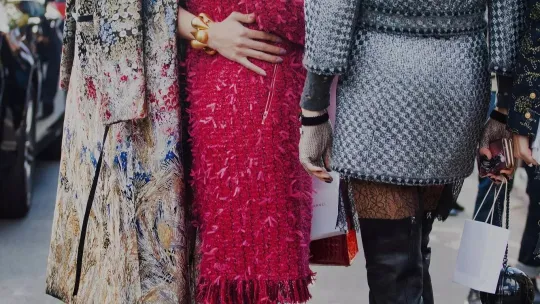
Visual identity of luxury brands: the keys to success
The visual identity of a luxury brand defines the way it aspires to be perceived. Unlike brand image, which reflects the customer's perception, visual identity thus allows the construction of the vision one wishes to project. From colours to the choice of materials and designs, everything is conceived to convey a message of exclusivity and sophistication. But are the keys to success only a matter of logo?
What is visual identity and why is it essential?
Definition and role in luxury branding
Visual identity is the set of graphic elements that embody the universe of a brand: logo, typography, colour palette, visual design, packaging, but also the artistic direction of advertising campaigns. It constitutes the first concrete expression of luxury branding, the one that captures attention well before the product speaks for itself.
In the highly codified universe of luxury, where every detail counts, visual identity does not simply have to be beautiful: it must convey values, a story, a lifestyle. It is a key strategic lever in building the brand image. A clean visual will evoke timelessness and sobriety, whereas a baroque style may suggest opulence or artisanal tradition.
A well-thought-out image strategy allows not only to establish the notoriety of a brand, but also to give it a distinctive signature that is immediately recognisable, like the Louis Vuitton monogram or Louboutin’s iconic red.
Influence on the perception and desirability of brands
In the luxury sector, perception is almost as important as the product itself. Visual identity acts like an emotional filter: it suggests rarity, refinement, exclusivity. A refined visual design is capable of creating dream, projection, and therefore desire.
A simple packaging detail can be enough to transform the product into a cult object, like the Chanel perfume bottles, the Hermès orange box or the Dior bags carefully wrapped in tissue paper. These visual codes were not installed by chance: they nourish an immersive customer experience and directly contribute to the perceived value of the product.
Key elements of the visual identity of a luxury brand
Logo and typography: strategic choices
The logo is much more than a simple graphic emblem: it is the central element of any image strategy. In luxury branding, it embodies the essence of the brand, its philosophy and its promise. Minimalist or sophisticated, symbolic or typographic, it must be immediately identifiable and timeless, like Chanel’s double C or Hermès’s prancing horse.
Typography also plays a fundamental role. It subtly conveys the universe of the brand: fine and elegant letters will express discreet sophistication, while bolder or handwritten lettering will evoke character, authenticity or heritage. Each typographic choice thus contributes to the overall visual design, influencing the consumer’s perception from the first moment.
Colours and graphic universe: creating a unique signature
Brands pay particular attention to the choice of colours to define their identity. A shade of midnight blue, a discreet gold, a deep black or an intense white can become powerful visual signatures. These codes are used both in a logic of elegance, recognition and harmony.
But beyond colours, the entire graphic universe must reflect the DNA of the brand: artistic direction, photography, staging, visual materials... Each element contributes to the overall emotion. The challenge? To create an original and coherent aesthetic across all media, physical as well as digital, without ever falling into banality or trendiness.
Packaging and product design: coherence and prestige
In luxury, packaging is not only used to protect a product: it tells a story, extends the experience, enhances the object. It is the first sensory interface between the brand and its client. A magnetic box, a satin ribbon, tissue paper: every detail reinforces the image strategy and justifies the perceived value. Packaging is strategic because, as Coco Chanel said: “You never get a second chance to make a first good impression.”
Product design follows the same logic: each shape, each material, each finish must be in perfect harmony with the brand’s universe. Product excellence cannot exist without excellence in presentation. It is this constant pursuit of coherence and prestige that allows luxury houses to build a strong and lasting emotional relationship with their clientele.
The MSc In Global Luxury Brand Management at Sup de Luxe is designed for those who wish to understand international luxury strategies, master high-end communication codes and manage prestigious brands. Through a complete programme combining theoretical courses, case studies and interventions from professionals in the sector, you will develop a strategic and operational vision of luxury, while immersing yourself in its creative universe.
How do luxury brands preserve and modernise their visual identity?
Evolution of visual codes in response to new trends
Luxury is often perceived as timeless, attached to well-established graphic and aesthetic codes. Yet, to remain desirable, a luxury brand must know how to make its visual design evolve without ever betraying its DNA. It is a subtle balancing act: preserving heritage while injecting modernity that speaks to new generations.
Some houses opt for partial rebranding, modernising their typography or simplifying their logo to embrace a more refined aesthetic. Others introduce new colour palettes or new forms of packaging, in line with contemporary issues such as eco-design. The essential thing is to remain faithful to the original image strategy, while integrating the cultural, social or environmental evolutions that shape today’s luxury.
Luxury and digital: adapting brand image to new media
With the explosion of digital channels, visual identity is no longer limited to physical shop windows or print campaigns. It must now be embodied on Instagram, in newsletters, on e-shops, in immersive experiences in augmented reality, even in the metaverse. This change imposes a deep reflection on visual coherence and the adaptability of each graphic element.
Brands must conceive their luxury branding in a logic of fluidity: responsive logos, readable typography on mobile, colours that adapt to screens, instagrammable packaging... Digital luxury loses none of its demand for quality: on the contrary, it requires even finer mastery of each detail. For in a world saturated with images, only a strong and well-conceived visual identity allows one to stand out with elegance.
Visual identity is a key element in creating the exclusivity and sophistication that characterise luxury brands. From the colours used to the typography, each element is designed to convey an image of perfection and exclusivity. Maintaining a strong identity is one of the keys to success, provided of course that only high-quality products are offered.

